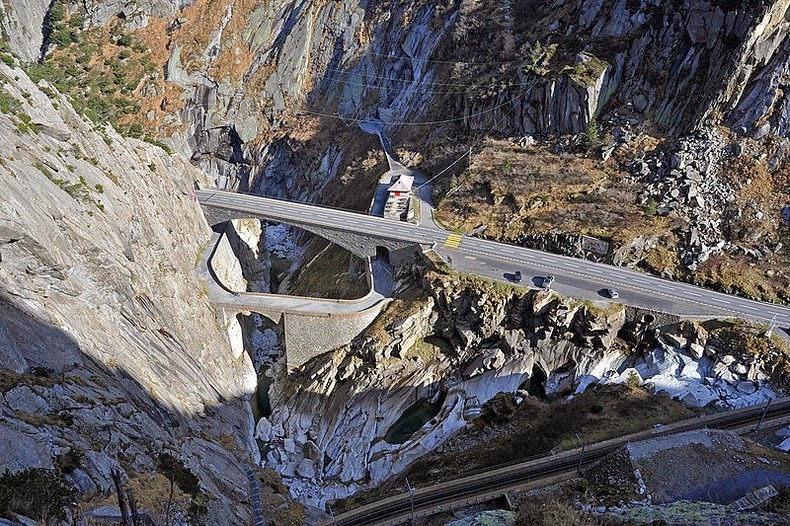A lot of ancient bridges across Europe are referred to as the Devil’s Bridge. These bridges were built under such challenging conditions that successful completion of the bridge required a heroic effort on the part of the builders and the community, ensuring its legendary status. This particular devil’s bridge or Teufelsbrücke is located across the Schöllenen Gorge in the scenic Reuss valley in the canton of Uri, in Switzerland. According to the legend, it was so hard to build a bridge here that a desperate Swiss herdsman wished the devil would make a bridge. The devil appeared and offered to build the bridge on the condition that the soul of the first to cross would be given to him. After the bridge was built, the villagers outsmarted the devil by sending a goat across the bridge. Angered by the trick, the devil picked up a large stone in order to smash the bridge to pieces. On his way to the bridge the devil met an old woman wearing a cross, which scared the devil causing him to drop the stone and flee.

The old Devil’s bridge (below) and the new Devil’s Bridge (above) and the Matterhorn-Gotthard Railway.
The Schöllenen Gorge is an important access route and the shortest transit to the St. Gotthard Pass, but it was generally not used until the early 13th century because it involved crossing the turbulent Reuss river, swollen with snowmelt during the early summer. The first bridge across the river was built in 1230. It was a wooden bridge and needed frequent maintenance.
In the 16th century, the wooden bridge was replaced by a stone arch bridge. The road was essentially a mule track that only allowed for the transportation of goods by mule, up to the beginning of the 19th century. In 1799, this bridge witnessed one of the most dramatic battles of Suvorov's Italian and Swiss expedition which took place during the Napoleonic Wars. During this battle the bridge was heavily damaged by the retreating French army. The bridge gave away in a storm in 1888.
A new bridge was built in 1820 and it took 10 years to complete, demonstrating the difficulty of the task. By the middle of the 20th century, the second bridge was no longer able to handle the volume of traffic it received, and a concrete bridge, featuring two lanes was built in 1958 to accommodate heavier flow. The second devil's bridge still exists today but is not used.
In 1994, the Swiss government issued a commemorative coin for the Teufelsbrücke. The obverse features a stylized scene of the devil holding the devil’s stone – the Teufelsstein - approaching the bridge to smash it. The 220 ton rock, allegedly picked up by the devil, is still there, though it had to be moved by 127 meters in order to make room for the new Gotthard road tunnel.

The Devil's Bridge in the Schöllenen Gorge on the Way across the St. Gotthard Pass with a Mule Train, before 1805. A painting by Swiss painter Peter Birmann (1758 - 1844).

The old devil’s bridge in a 1934 picture of the Schöllenen Gorge.



Leaning bridge of the Schöllenen railway near the devil's bridge.

The old devil’s bridge

No comments:
Post a Comment